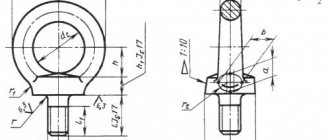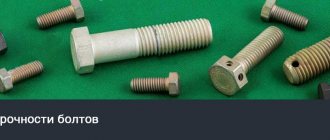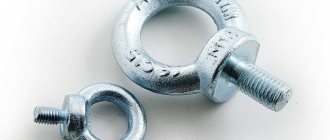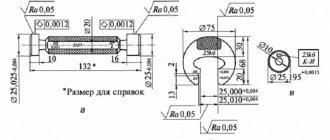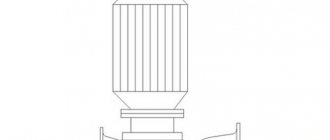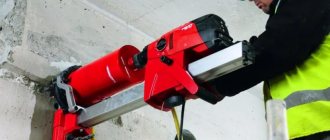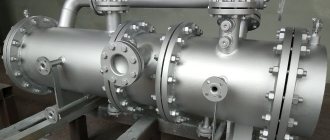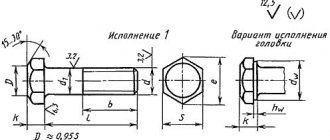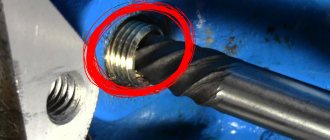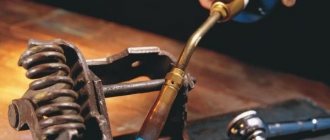GOST 4751-73
GOST 4751-73 Group G86
STATE STANDARD OF THE USSR UNION
EYE BOLTS Specifications Screw rings. Specifications
Date of introduction 1974-07-01
INFORMATION DATA
1. APPROVED AND ENTERED INTO EFFECT by the State Committee of Standards of the Council of Ministers of the USSR dated May 10, 1973 No. 1169
2. Inspection period - 1993, frequency - 5 years
3. INSTEAD GOST 4751-67
4. REFERENCE REGULATIVE AND TECHNICAL DOCUMENTS
| Designation of the referenced technical document | Item number |
| GOST 9.014-78 | 5.6 |
| GOST 9.301-86 | 2.15, 3.1 |
| GOST 9.302-88 | 4.6 |
| GOST 515-77 | 5.3 |
| GOST 1050-88 | 2.1 |
| GOST 1759.0-87 | 215 |
| GOST 2991-85 | 5.3 |
| GOST 7505-89 | 2.3 |
| GOST 9012-59 | 4.2 |
| GOST 10549-80 | 2.10 |
| GOST 14192-96 | 5.8 |
| GOST 15150-69 | Introductory part |
| GOST 16093-81 | 2.10, application |
| GOST 24705-81 | 2.10, application |
5. Tested in 1988. The validity period was removed by Decree of the USSR State Standard of December 16, 1988 No. 4162
6. REISSUE (June 1998) with Amendments No. 1, 2, 3, 4, approved in May 1979, January 1983, December 1988, August 1990 (IUS 7-79, 5-83 , 3-89, 11-90)
This standard applies to eye bolts intended for lifting, lowering or holding products by weight during installation and rigging work for all operating conditions in accordance with GOST 15150. (Modified edition, Amendment No. 4).
MAIN PARAMETERS AND DIMENSIONS
1. MAIN PARAMETERS AND DIMENSIONS
1.1. The design and main dimensions of the eye bolts must correspond to those indicated in the drawing and table. 1.
Table 1
Dimensions in mm
| Thread symbol | Applicability | , no less | Weight 1 piece, kg | |||||||||
| M8 | 36 | 20 | 8 | 20 | 10 | 12 | 6 | 18 | 12 | 4 | 0,05 | |
| M10 | 45 | 25 | 10 | 25 | 12 | 16 | 8 | 21 | 15 | 2 | 0,12 | |
| M12 | 54 | 30 | 12 | 30 | 14 | 18 | 10 | 25 | 19 | 6 | 0,19 | |
| M16 | 63 | 35 | 14 | 36 | 16 | 20 | 12 | 32 | 25 | 0,31 | ||
| M20 | 72 | 40 | 16 | 40 | 19 | 24 | 14 | 38 | 29 | 8 | 0,50 | |
| M24 | 90 | 50 | 20 | 50 | 24 | 29 | 16 | 45 | 35 | 3 | 12 | 0,87 |
| M30 | 108 | 60 | 24 | 63 | 28 | 37 | 18 | 55 | 44 | 15 | 1,58 | |
| M36 | 126 | 70 | 28 | 75 | 32 | 43 | 22 | 63 | 51 | 18 | 2,43 | |
| M42 | 144 | 80 | 32 | 85 | 38 | 50 | 25 | 72 | 58 | 4 | 20 | 3,72 |
| M48 | 162 | 90 | 36 | 95 | 42 | 52 | 30 | 82 | 68 | 22 | 5,54 | |
| M56 | 180 | 100 | 40 | 105 | 48 | 60 | 34 | 95 | 78 | 25 | 8,09 | |
| M64 | 198 | 110 | 44 | 115 | 52 | 65 | 40 | 110 | 93 | 10,95 | ||
| M72x6 | 234 | 130 | 52 | 135 | 62 | 75 | 45 | 115 | 98 | 5 | 35 | 18,54 |
| M80x6 | 270 | 150 | 60 | 160 | 70 | 88 | 50 | 125 | 108 | 25,40 | ||
| M100x6 | 324 | 180 | 72 | 190 | 85 | 105 | 60 | 150 | 133 | 40 | 43,82 |
An example of a symbol for an eyebolt with M8 thread without coating:
Eye bolt M8 GOST 4751-73
The same, with fine thread M100x6, with coating 01 (zinc with chromating), thickness 9 microns:
Eye bolt M 100 x 6.019 GOST 4751-73
(Changed edition, Amendment No. 1, 2).
1.2. The lifting capacity of the eye bolts must correspond to those indicated in the table. 2.
table 2
| Load capacity per 1 eye bolt, kg, + | |||
| when directing the slings | |||
| at an angle of 45° from the vertical axis of the eye bolt | |||
| Thread symbol | along the vertical axis of the eye bolt | in the plane of the ring | with deviation from the plane of the ring |
| M8 | 120 | 80 | 40 |
| M10 | 200 | 125 | 65 |
| M12 | 300 | 175 | 90 |
| M16 | 550 | 250 | 125 |
| M20 | 850 | 325 | 150 |
| M24 | 1250 | 500 | 250 |
| M30 | 2000 | 700 | 350 |
| M36 | 3000 | 1000 | 500 |
| M42 | 4000 | 1300 | 650 |
| M48 | 5000 | 1650 | 800 |
| M56 | 6200 | 2000 | 1000 |
| M64 | 7500 | 2500 | 1250 |
| M72x6 | 10000 | 3500 | 1750 |
| M80x6 | 14000 | 4500 | 2250 |
| M100x6 | 20000 | 6500 | 3250 |
Notes:
1. When lifting a load, the direction of the slings at an angle from the vertical axis of the eyebolt of more than 45° is not allowed.
2. To install in the same plane the rings of two eyebolts screwed in until they stop, it is allowed to use flat washers with a thickness of:
— up to 1 mm — for eye bolts with M8-M12 threads;
- no more than half the thread pitch - for eye bolts with threads over M12.
1.3. The design and dimensions of the sockets for eye bolts are given in the Appendix.
Features and scope
The distinctive qualities of the eye fastening are the steel grade and thread pitch. So, a bolt made from st. 20 with a pitch of threaded ridges M 8 - M 64 should have a hardness rating from 105 HB to 149 HB and a complete absence of scale and traces of rust.
The force of lifting an object depends on the angle of fastening of the bolt relative to the plane of the load. The angle of tension of the slings relative to the vertical axis of the fastening is formed by the cargo mass of the object being moved and can range from 30 kg to 20 tons. The safest lifting of heavy loads is carried out by creating a force along the axis of the screw rod.
Hardware made in accordance with GOST 4751–73 from carbon steel is manufactured in different sizes and shapes. In addition to the ring-shaped head, the fastening element can be equipped with a hook. To secure the device to an object, the threaded tip of the product is screwed into a hole on the body of the load, and a sling or cable is fixed in the eye of the bolt.
TECHNICAL REQUIREMENTS
2.1. Eye bolts must be made of steel grade 20 or 25 (subgroup a) according to GOST 1050 by stamping. Production by forging is allowed.
Compliance of the material with the prescribed grades must be confirmed by a certificate from the metal manufacturer.
(Changed edition, Amendment No. 1).
2.2. (Deleted, Amendment No. 1).
2.3. Technical requirements for stamped forgings in accordance with GOST 7505, accuracy class - II, degree of complexity - SZ.
Note. When producing eye bolts by free forging in backing dies, it is allowed to increase the plus tolerances by 2 times.
(Changed edition, Amendment No. 1).
2.4. A flat on the inner circumference of the ring is allowed, resulting from deburring, provided that the size is maintained within the tolerances of clause 2.3.
2.5. Welding or sealing of defects is not allowed.
2.6. Eye bolts after stamping or forging must be normalized and free of scale.
2.7. The hardness of normalized eye bolts must correspond to that indicated in the table. 3.
Table 3
| Hardness of HB eye bolts with thread size | ||
| steel grade | from M8 to M64 | from M72x6 to M100x6 |
| 20 | 105-149 | 95-121 |
| 25 | 134-187 | 105-149 |
One repeated heat treatment is allowed.
2.8. Center holes are not allowed on the eyebolt ring.
2.9. Cuts on the machined part of the shank are not allowed.
2.10. Thread - in accordance with GOST 24705 with a tolerance range of 8g in accordance with GOST 16093. Dimensions of chamfers and thread runs - in accordance with GOST 10549. The amount of thread run-out for the angle of the tool intake part is 20°.
Note. When applying the coating, the specified dimensions and roughness must be ensured.
2.11. The thread should not have broken threads, burrs or dents.
2.12. Perpendicularity tolerance of the thread axis over a length of 100 mm relative to the reference plane of the ring:
0.10 mm - for eye bolts with threads from M8 to M16;
0.05 mm » » » » » from M20 to M100x6.
2.13. Tolerance for symmetry of the thread axis relative to the general planes of symmetry of the eye bolt:
T 1 mm - for eye bolts with threads from M8 to M12;
T 2 mm » » » » » from M16 to M48;
T 4 mm » » » » » from M56 to M100x6.
2.12-2.13. (Changed edition, Amendment No. 2).
2.14. Eyebolts must withstand a strength test with a load equal to twice the rated load capacity.
The permissible deviation of this load is ±5%.
2.15. Eye bolts can be manufactured with a coating. Types and symbols of coatings - according to GOST 1759.0.
Technical requirements for coatings and surface quality of eye bolts before coating are in accordance with GOST 9.301.
(Changed edition, Amendment No. 1).
Manufacturing of eye bolts GOST 4751 73
As a rule, eye bolts are produced by stamping, but it is also possible to produce them by forging.
Soldering of bolts is under no circumstances allowed. For steel bolts of grade 25, these GOST values are determined by 134-187НВ and 105-149НВ .
- Product strength testing is the ability of eye bolts to hold double load (twice as much as stated in GOST).
- The thread of the product should not have dents, burrs or dents of broken threads.
The manufacturing plant of the product is obliged to monitor the quality of parts for compliance with GOST standards. Any batch of bolts is subject to testing for compliance with the GOST standard.
All eyebolts must have markings on the shackle that include:
- thread designation (for products with M 8-M 16 threads, only the factory trademark can be applied);
- trademark of the factory that manufactured the mount.
As a rule, marking is done by stamping, but the impact method is also used.
Products are packaged at the factory, where they are packed in wooden boxes, pre-lined with thick paper for packaging. Each box is a package of bolts from one batch. The maximum weight of one box should not be more than 60 kg . Any batch of products, according to GOST, must be accompanied by a corresponding document with the trademark of the manufacturer and an indication of the name of the product, the number of pieces in the pack, the results of inspections and testing for the quality of the product. In the same way, the same marking is applied to each box.
The safety regulations on ships indicate that before operating lifting equipment, it must be checked for defects, including checking the eye fastenings for corrosion of the product. This proves the importance attached to this type of product in the navy. Corrosion of this small part can lead to dire consequences. On ships for transportation, it is often necessary to lift various heavy loads , and a product such as an eye bolt significantly determines the reliability of the entire lifting structure.
ACCEPTANCE RULES
3.1. The manufacturer must conduct acceptance tests of eye bolts. During acceptance tests, eye bolts are checked:
before machining:
— for compliance with the requirements of clause 1.1 in terms of dimensions obtained by stamping or forging and clauses. 2.3, 2.4: in the case of production by open forging in backing dies - each eye bolt; in the case of production by volumetric stamping - 5% of the batch, but not less than 5 pieces;
— for compliance with the requirements of paragraphs. 2.5 and 2.6 each eye bolt;
— for compliance with the requirements of clause 2.7 10% of the lot, but not less than 5 pieces;
after machining:
— for compliance with the requirements of clause 1.1 (dimensions, and and) clauses. 2.8-2.14 each eye bolt;
— for compliance with the requirements of clause 2.15 — according to GOST 9.301.
Note. The batch consists of eye bolts of the same size, made of steel of the same grade, and heat treated together.
(Changed edition, Amendment No. 1).
3.2. If unsatisfactory test results of eye bolts are obtained according to at least one of the indicators, repeated tests are carried out on a double number of samples taken from the same batch, according to the full program. The results of repeated tests are final and apply to the entire batch.
(Introduced additionally, Amendment No. 2).
Types of steel eye fastenings
In addition to their intended purpose, fastenings of a special design are also used in the formation of a non-standard lifting system. Such products are eye bolts with a hinge (swivel), which prevents the rotation of a load with longitudinal rings or rods when lifting heavy, oversized and light objects.
Any innovative design is manufactured according to the conditions of the state standard, ensuring the safety of personnel and the integrity of the cargo. TU and GOST differ from manufacturer to country, but the main indicator of product reliability is considered to be compliance with the “International Standard DIN 580”, adapted to the interstate GOST 4751−73. All products must have alphanumeric markings and the manufacturer's trademark on the headband (M8, M16, etc.).
The technical characteristics of bolts are determined by the manufacturing method:
- Stamping
- Forging.
The finished product is fired at high temperature.
The following method is used for marking:
- Stampings
- Impact application.
Each batch of products is equipped with a Certificate of Conformity with the manufacturer’s logo, batch number, number of fasteners, and the result of the examination. Products should be packaged in layers, with oiled paper between layers.
TEST METHODS
4.1. Compliance with the requirements of clause 2.3 is checked by external inspection without the use of magnifying devices.
Magnifiers up to three times magnification can be used.
(Changed edition, Amendment No. 2).
4.2. Hardness (clause 2.7) is determined according to GOST 9012 on the generatrix of the supporting part of the ring.
4.3. The threads (clause 2.10) are checked with maximum gauges.
4.4. The deviation from the perpendicularity of the axis of the threaded shank to the supporting surface of the ring (clause 2.12) is checked with an angle template or feeler gauge along the clearance between the supporting surface of the ring and the end surface of the control gauge.
4.5. Compliance of eye bolts with the requirements of clause 2.4 is checked by a tensile test with holding under load for 10 minutes.
The load must be applied along the axis of the eyebolt rod.
The application of the load should be smooth, without jerking.
After removing the load, there should be no residual deformation, cracks or tears in the eye bolts.
The absence of residual deformations is determined by checking the dimensions along the axis of the eye bolts before and after testing.
The absence of cracks and tears is checked by external inspection using a magnifying glass with at least four times magnification.
4.6. The thickness of the coating layer (clause 2.15) is checked on the eyebolt ring. Methods for checking the quality and thickness of the coating are in accordance with GOST 9.302.
4.7. (Deleted, Amendment No. 2).
Design and manufacturing technology
An eye bolt DIN 580 is a metal ring with a cylindrical rod on which a metric thread is applied. Part of the rod with thread turns is screwed into the embedded components of the structures. The production of eye bolts is carried out using two technologies: stamping or casting. Such low-carbon steel fastening elements are subjected to a galvanizing procedure, due to which no signs of corrosion appear on their surface. A protective layer of zinc is applied using one of the following methods:
- hot. It is the most economical and reliable. Products are immersed for a certain time in molten zinc;
- galvanic. Fasteners are placed in a container with a solution of zinc salts. After passing current, particles of this metal settle on the bolts;
- cold. A special solution containing zinc powder is applied to the workpiece. The degree of resistance to rust here is noticeably higher than with galvanizing, but lower compared with hot-dip galvanizing;
- diffuse. The workpieces are treated with vapors of the Zn element with a temperature in the range from 800 to 900°C, or with fine powder of this metal at 290 – 450°C. The result of this method is comparable to hot-dip galvanizing, except for the worse appearance of the final product.
Increased strength is ensured by additional heat treatment. As a result, the lifting capacity of the eye bolts reaches 20 tons.
Areas of application
The specifics of the design and manufacturing methods have led to the use of eye bolts in the following areas:
- rigging work: various types of moving heavy objects - lifting, loading, unloading, rearranging, etc.
- production of motor vehicles - used for towing;
- construction: used when performing work at heights, during the installation of technological equipment, for loading/unloading, for moving building structures, etc.
In addition, fasteners of this type have found application in work that requires completion in the shortest possible time: installation of tents for various events, domes of traveling circuses, tourist tents. Watercraft are moored to the pier using eye bolts.
